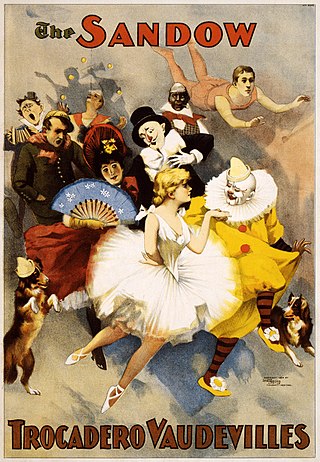
Vaudeville is a theatrical genre of variety entertainment which began in France at the end of the 19th century. A Vaudeville was originally a comedy without psychological or moral intentions, based on a comical situation: a dramatic composition or light poetry, interspersed with songs and dances. It became popular in the United States and Canada from the early 1880s until the early 1930s, while changing over time.
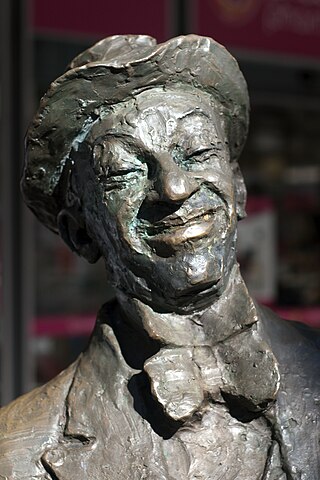
Roy Rene was an Australian comedian and vaudevillian. As the bawdy character Mo McCackie, Rene was one of the most well-known and successful Australian comedians of the early 20th century, and the local answer to Charlie Chaplin.
George Stephenson "Onkus" Wallace, was an Australian comedian, actor, vaudevillian and radio personality. During the early to mid-20th century, he was one of the most famous and successful Australian comedians on both stage and screen, with screen, song and revue sketch writing amongst his repertoire. Wallace was a small tubby man with goggle eyes, a mobile face and croaky voice who appeared in trademark baggy trousers, checkered shirt and felt hat. His career as one of Australia's most popular comedians spanned four decades from the 1920s to 1960 and encompassed stage, radio and film entertainment. Ken G. Hall, who directed him in two films, wrote in his autobiography that George Wallace was the finest Australian comedian he had known.

Theatre of Australia refers to the history of the live performing arts in Australia: performed, written or produced by Australians.

James Cassius Williamson was an American actor and later Australia's foremost impresario, founding the J. C. Williamson's theatrical and production company.

Harry Rickards, born Henry Benjamin Leete, was an English-born baritone, comedian and theatre owner, most active in vaudeville and stage, first in his native England and then Australia after emigrating in 1871.

Toni Lamond AM, is an Australian vaudevillian, cabaret performer, singer, actress, dancer, comedian, writer and television and radio personality/presenter. She has had a successful career spanning some 80 years, both locally and internationally, including in the United Kingdom and United States.
Niles Marsh was a female impersonator who began his career on the Broadway stage and then, from the early 1920s to the mid-1940s, rose to become one of the best known drag performers on the American vaudeville and nightclub circuits. He was one of many such artists who, during that period, encapsulated what was known as the Pansy Craze.
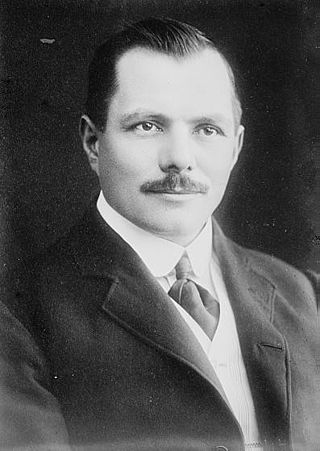
Hugh Donald "Huge Deal" McIntosh was an Australian theatrical entrepreneur, sporting promoter and newspaper proprietor
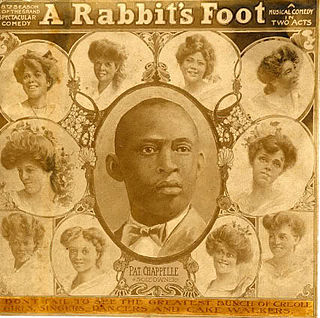
Black Vaudeville is a term that specifically describes Vaudeville-era African American entertainers and the milieus of dance, music, and theatrical performances they created. Spanning the years between the 1880s and early 1930s, these acts not only brought elements and influences unique to American black culture directly to African Americans but ultimately spread them beyond to both white American society and Europe.

Sir Benjamin John Fuller was an English-born Australian theatrical entrepreneur, best known for establishing the theatre company that bears his name.
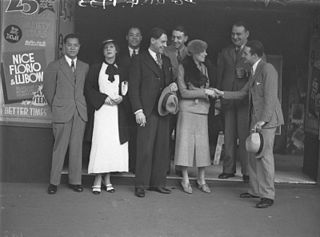
The New Tivoli Theatre, Sydney, previously known as the Adelphi Theatre and the Grand Opera House, was a theatre and music hall at 329, Castlereagh Street, Sydney, Australia, which was long at the heart of the Tivoli circuit.

The Sentimental Bloke is a 1961 Australian musical by Albert Arlen, Nancy Brown and Lloyd Thomson based on Songs of a Sentimental Bloke by C.J. Dennis. Set in Melbourne, it is one of the most successful Australian musicals of the 20th century.

Irving Sayles was an African-American vaudeville entertainer. He spent much of his life in Australia as a popular minstrel show performer, touring the Tivoli circuit. He performed coon songs and employed a self-deprecating humor involving comic interpretations of plantation slavery that reinforced negative racial stereotypes.
The Tivoli Theatre was an important venue in Melbourne's East End Theatre District, located at 249 Bourke Street near Swanston Street. The first theatre on the site opened in 1866, rebuilt in 1872 as the Prince of Wales Opera House, rebuilt again in 1901 as the New Opera House, and renamed the Tivoli in 1914 when it joined the Tivoli circuit. The theatre closed in 1966.

Tivoli is an Australian dance musical that pays tribute to the Tivoli variety and revue circuit. It was directed and choreographed by Graeme Murphy from a scenario by Murphy and Kristian Fredrikson, with dialogue by Linda Nagle and Paul Chubb. Music incorporated existing songs from Tivoli productions, original songs by Max Lambert and Linda Nagle, and an original musical score by Graeme Koehne.

The Garrick Theatre was a theatre and music hall at 79–83 Castlereagh Street in Sydney from 1890 to 1929. The theatre was renamed the Tivoli Theatre in 1893 and operated as a popular vaudeville venue. It was destroyed by fire in 1899 and rebuilt. The theatre closed in 1929.
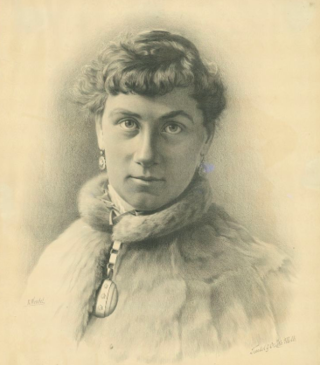
Kate Rickards was an Australian trapeze artist and later a musical theatre actress. Born in Melbourne, she began performing as a trapeze artist in Australia at the age of 11 under the name "Katie Angel" and later toured the United States, England, and South Africa under the management of the British-born vaudeville performer and impresario Harry Rickards. She and Rickards married in 1880, after which she had a career as a musical theatre actress under the name "Kate Leete". Following her retirement from the stage in 1894, she designed costumes for the Rickards shows for several years and devoted herself to charity work. She died at the age of 59 aboard a ship sailing from England to Australia and was buried at sea.
J. C. Williamson's, formerly Williamson, Garner, & Musgrove and Williamson and Musgrove, was an Australian theatrical management company and theatre owner. With its beginnings in the theatrical productions of J. C. Williamson and his partners in the nineteenth and early twentieth century, the company J. C. Williamson Limited was established in 1910. Colloquially known as The Firm or JCW, the company dominated Australian commercial theatre in the twentieth century and at one time was described as the largest theatrical firm in the world. It closed under financial pressure in 1976.

Minnie Everett was an Australian ballet-mistress and producer, closely associated with the J. C. Williamson's company. She was the world's first woman producer of Gilbert and Sullivan operettas.
















